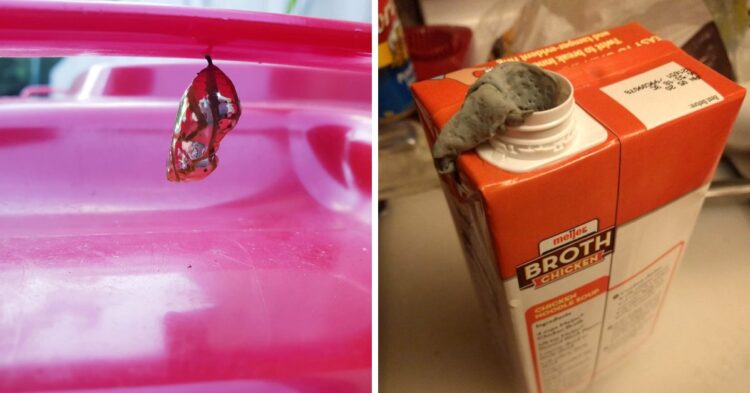The world is full of far too many weird and wonderful — and, let’s face it, gross — things for one person to identify everything, but now that we have the internet, we’re not forced to remain ignorant.
Instead, you can just snap a pic and post it on a forum like the r/whatisthisthing subreddit and someone will know the answer.
Because the internet knows everything .
“Small device found taped under a shelf in a locked cabinet at work that few have access to,” began the explanation.

” Found it because it was making a chirp beat noise. Is it a small speaker/recorder? About half the size of a deck of cards.”
While your concern about strange, seemingly homemade little devices is probably warranted, this little bugger is just meant to annoy you. It’s a DIY version of a device literally called the “Annoy-a-tron” .
All it does is make random beeps and chirp noises intended to drive everyone in the vicinity slowly crazy.
“My grandma found this sword in her attic when they first moved to their house 60 years ago.”

“Any idea where its from?” asks user Joshhawk. Which is a way cooler find than the creepy rocking chair that was in my attic.
Commenters thought it looked like a Freemason sword, but then TripleSixZero found a link to an almost identical sword. That sword was made by The Henderson Ames Co., a company in Kalazamoo, Michigan that operated from 1850 to 1923.
So this sword isn’t likely a real Templar or Freemason sword, but it’s still pretty darn cool.
“I know it’s an egg sack of some kind, but to what?? Found on a beach in USA.” —CC-larkbird

It’s definitely a weird sort of egg sack, isn’t it?
It’s sometimes called a “mermaid’s necklace” and belongs to a knobbed whelk . The knobbed whelk is a really big, mean sea snail that lives along the North Atlantic coast of the U.S. Each section of the “necklace” contains up to a hundred eggs.
The strings of eggs are buried in the ocean floor, but can sometimes wash up on shore.
GreaterRococo wondered what these squares all over walls in cities were for.

Which is a valid question when they manage to seem both random and put there for a purpose.
And they do play an important role. They’re called anchor plates , and help structurally reinforce buildings constructed before modern techniques became commonplace.
They help prevent masonry from bowing outward by running a long steel or cast iron rod between two opposing walls, basically forcing them to hold each other up. The rod is probably threaded through the ceilings, which explains why the cap plates seem so random from outside.
“Not a cheese grater, but it kinda looks like one.” —maths222

I can see why maths222 was confused. Most cheese graters or rasps have raised ridges to catch the thing your grating, but these holes are flat.
It turns out that this is part of a spätzle maker. Spätzle is a European egg noodle used in many dishes from the area. Depending on which country you’re in, they may be called by another name, but it’s basically a dough made from flour, eggs, salt, and water. Pressing it through this tool turns the dough into noodles.
User AugustTB describes their find as, “Some kind of African pickaxe found while working at a Goodwill store.”

They weren’t far off. The tool is probably an adze , which is a style of cutting tool that dates as far back as the stone age, and versions of it can be seen in Egyptian art.
The tool could be small, like an axe, or large and meant to be swung with two hands. The base was made from wood, with a head that stuck out perpendicularly to the shaft. Sharp stones or, later, metal blades were tied to the head.
“What are the four spheres atop the boat for?” asked achen6.

They do stick out like a sore thumb, don’t they?
The spheres are called radomes and they protect radar antennas from weather. In fact, the name is a portmanteau of the words “radar” and “dome.” On ships, they are often used to protect satellite equipment too.
So those spheres are pretty important on a cruise ship like the one pictured. Not only do they keep the ship on course, but they’re also what allows you to tweet the whole time you’re aboard.
“This piece of ice shooting up from the ice tray that hasn’t moved in the freezer.” —Mashine_Throwaway

Ice spikes are actually pretty common, but you don’t often find them in your freezer .
They form because water expands as it freezes. That’s why ice cubes are always bigger than the actual amount of water you put in the tray.
If the cube happens to freeze from the outside in, the expanding ice around the outside leaves less room for the remaining water, forcing it upward.
Btbjr had a question about something he found at the hardware store.

“It costs over $200 but I have no idea what it is for,” he said .
Since he looks to be in the yard tools section, it’s a valid question. Most rakes and shovels don’t cost hundreds of dollars and this thing looks like a weird metal pool net.
Which is actually sort of close. The tool is a clam rake. You use it to rake through the mud, so it needs to be heavy duty, and the clams collect in the metal net.
“Fossil?” wonders melissam217.

“Anyone know what this thing in my grandfather’s fossil collection is? Found in Big Bend, Texas.”
It’s not a fossil, but a piece of chalcedony . This is a form of silica that is most often found in the form of dull, waxy crystals like this one.
But some semi-precious stones are also forms of chalcedony, such as agate, aventurine, heliotrope, and onyx. Jewelry and carvings dating as far back as the Bronze Age have been found made of chalcedony.
“What are those small, transparent, slippery beads?,” asked Reddit user lnnnnnt.

They expanded on the question, explaining that the “beads” covered an area about five inches square and weren’t one solid mass.
They’re definitely eggs, probably snail or slug. One commenter linked to a picture of eggs belonging to the Papillifera bidens species of snail that look very similar, but another noted that it could be a leopard slug.
I looked both up and since lnnnnnt said they are in Germany, I think the leopard slug is more likely, because it likes gardens and is native to Europe.
“Why are these black marks over my neighbors’ old power saving lamp?” —lawinchen

And this is another reason why I’m glad we’ve moved on from old fashioned incandescent light bulbs.
The black marks are either burned ceiling paint or burned dust that was clinging to the popcorn texture. Incandescent and halogen bulbs produce more heat than light, which is why they’re so inefficient. This may have been called a “power saving” lamp, but those burns tell a whole different story.
Sometimes the coolest stuff is found in school science labs.

That’s where TurbulentDescent found this cool device. It’s made up of a series of hollow metal tubes all collected together on a solid pin handle.
Turns out that it’s a specialized tool called a “cork borer” , which is used to create holes in corks. If you’ve ever seen a glass beaker with a cork in the top, but there is a piece of tubing going through the cork into the liquid inside, this is how they do that.
“I was walking through a park with my brother and we came across a gravel pit,” begins jackhillary23’s explanation.

Though it totally sounds like the beginning of a Stephen King novel, there was no monster in the pit.
“We found this sphere/ball buried half way in the ground. We have no idea what it is or what the numbers and letters mean. It seems to be made out of some sort of hard foam. It is very durable.”
Turns out that it’s a milling ball for grinding gravel, which explains where it was found.
Gucci_Louchi found this strange device taped under a cafe table.

“It only has an on/off button,” they explained . Commenters quickly identified it as a really horrible piece of ad tech! Ugh.
The device, called Asirvia , will find any Android phone within a 400 yard radius and spam the phone with advertising messages. A company can preload their message and just leave the device in a public place.
Thankfully, it’s not too hard to avoid the spam. The device can only send the messages to phones with both location and Bluetooth turned on.
“This has my grandmother’s initials on it. She was born around 1910,” explains jmillson135.

I can see why jmillson135 might have raised an eyebrow at a decorative key that hid something inside, but it’s nothing nefarious.
It’s a perfume dabber! A very cute one too.
Apparently, the grandmother in question worked in Asia during the postwar years in the employ of the U.S. Department of Defense, so jmillson135 wonders if maybe it held poison instead of perfume. Grandma must have been a pretty cool lady.
“Does anyone know what this walking fish is called?” asked slaintrain.

Their question linked to an Instagram video that indeed showed a pair of very ugly fish walking on the sand. It’s super creepy and weird!
A few ideas were tossed around, but the fish were finally identified as Inimicus didactylus , a species of stonefish. Also known as a Bearded Ghoul, these guys like to hangout in the Indo-West Pacific, chilling in the bottom of lagoons and reefs where they camouflage really well.
Which sucks, because their venom is deadly to humans. Eep!
M1Fuentes just labelled this image “Alien Orange Edition.”

Which is definitely a legit way to describe this monstrosity. Frankly, if I discovered this, it would turn me off oranges entirely for a while.
And really, when the explanation involves the words “black rot” can you really blame me?
This is most commonly caused by a fungal pathogen that’s gotten in through the navel end of the orange and spreads throughout the inside. Most often, it just results in gross black spots, but this one had time to harden.
If it caused a six hour delay, I’d want to know what it was too.

That’s what happened to user BootyStanks. Their flight was forced to make a landing and they managed to snap a pic of the part that needed to be replaced.
It’s an air filter, which seems like a small thing to force a big landing, but air quality is pretty important that high up. This one is for the cabin, and according to someone from the airline, had begun to smoke and make weird noises. Better safe than sorry!
Mayorofcrazytown99 wondered why more and more lady bugs were huddling in their bathroom.

The question sparked a bunch of commenters noting that this happens to them at this time of year too.
That’s because it’s hibernation season for the lady bugs and they often look for warm corners where they can all nestle together through the winter months. Which is absolutely adorable, but kind of annoying when that warm, cozy spot is in your bathroom.
It’s safe to leave them alone, and once they start to stir in spring, you can gently move them outside.
“Found this on my general waste bin, don’t want to harm it if I don’t know what it is. Any thoughts?” —scoobertsdoobert

It’s a cute little butterfly chrysalis! If possible, it would be best if scoobertsdoobert could just leave it alone until the butterfly emerges, but that might be hard if the bin is a shared one.
In the comments, I also learned that the difference between a chrysalis and a cocoon is what they’re made of. A chrysalis is hardened protein, while a cocoon is wrapped up silk.
No! Not the avocado!

“Found in my avocado,” says YonnyP, “No bruise on the outside, and it was hard/almost perfectly circular.”
Unlike the alien orange, this isn’t actually so bad. The small sphere is a reaction to the sting of a fruit spotting bug and is a sign of the avocado’s immune system working correctly to combat the sting.
The fruit is still safe to eat, but you should discard the stone and any discolored flesh before doing spreading the rest on your toast.
Add this to the list of things I never want to see again.

When Reddit user LiKWiDCAKE went to pour from a brand new box of chicken broth, they didn’t expect a weird gray scum to end up in the meal they were cooking.
They probably weren’t surprised when commenters immediately called it out as mold and recommended that LiKWiDCAKE return it (and any other boxes bought with it) to the store. Ew.
While it can be annoying to add an extra step, this is why many cooks recommend decanting ingredients in a separate container before adding them to the pot. Just in case.
I didn’t even need to read the comments to identify these!

“Found a bucket full of these weird metal things in the attic of the old house we just bought. What the hell are they?” — can1exy
They’re taps for collecting tree sap. Really old ones. Growing up, my family always spent Easter at my grandfather’s cabin, which was surrounded by maple trees. By the end of the holiday, we’d have dozens of jars of fresh maple syrup. My job was to collect the full buckets of sap from all the trees.















































